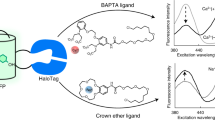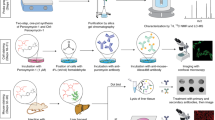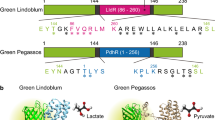Abstract
Magnesium plays a crucial role in many physiological functions and pathological states. Therefore, the evolution of specific and sensitive tools capable of detecting and quantifying this element in cells is a very desirable goal in biological and biomedical research. We developed a Mg2+-selective fluorescent dye that can be used to selectively detect and quantify the total magnesium pool in a number of cells that is two orders of magnitude smaller than that required by flame atomic absorption spectroscopy (F-AAS), the reference analytical method for the assessment of cellular total metal content. This protocol reports itemized steps for the synthesis of the fluorescent dye based on diaza-18-crown-6-hydroxyquinoline (DCHQ5). We also describe its application in the quantification of total intracellular magnesium in mammalian cells and the detection of this ion in vivo by confocal microscopy. The use of in vivo confocal microscopy enables the quantification of magnesium in different cellular compartments. As an example of the sensitivity of DCHQ5, we studied the involvement of Mg2+ in multidrug resistance in human colon adenocarcinoma cells sensitive (LoVo-S) and resistant (LoVo-R) to doxorubicin, and found that the concentration was higher in LoVo-R cells. The time frame for DCHQ5 synthesis is 1–2 d, whereas the use of this dye for total intracellular magnesium quantification takes 2.5 h and for ion bioimaging it takes 1–2 h.
This is a preview of subscription content, access via your institution
Access options
Access Nature and 54 other Nature Portfolio journals
Get Nature+, our best-value online-access subscription
$29.99 / 30 days
cancel any time
Subscribe to this journal
Receive 12 print issues and online access
$259.00 per year
only $21.58 per issue
Buy this article
- Purchase on Springer Link
- Instant access to full article PDF
Prices may be subject to local taxes which are calculated during checkout





Similar content being viewed by others
References
Touyz, R.M. Magnesium in clinical medicine. Front. Biosci. 9, 1278–1293 (2004).
Altura, B.M., Altura, B.T., Gebrewold, A., Ising, H. & Günther, T. Magnesium deficiency and hypertension: correlation between magnesium-deficient diets and microcirculatory changes in situ. Science 223, 1315–1317 (1984).
Resnick, L.M. et al. Intracellular and extracellular magnesium depletion in type 2 (non-insulin-dependent) diabetes mellitus. Diabetologia 36, 767–770 (1993).
Li, F.Y. et al. Second messenger role for Mg2+ revealed by human T-cell immunodeficiency. Nature 475, 471–476 (2011).
Castiglioni, S. et al. Magnesium homeostasis in colon carcinoma LoVo cells sensitive or resistant to doxorubicin. Sci. Rep. 5, 16538 (2015).
Feeney, K.A. et al. Daily magnesium fluxes regulate cellular timekeeping and energy balance. Nature 532, 375–379 (2016).
Trapani, V. et al. Intracellular magnesium detection: imaging a brighter future. Analyst 135, 1855–1866 (2010).
Romani, A.M. Magnesium homeostasis in mammalian cells. Front. Biosci. 12, 308–331 (2007).
Farruggia, G. et al. 8-Hydroxyquinoline derivatives as fluorescent sensors for magnesium in living cells. J. Am. Chem. Soc. 128, 344–350 (2006).
Maguire, M.E. Magnesium transporters: properties, regulation and structure. Front. Biosci. 11, 3149–3163 (2006).
Fatholahi, M., LaNoue, K., Romani, A. & Scarpa, A. Relationship between total and free cellular Mg2+ during metabolic stimulation of rat cardiac myocytes and perfused hearts. Arch. Biochem. Biophys. 374, 395–401 (2000).
Takeshi, K. et al. Mitochondria are intracellular magnesium stores: investigation by simultaneous fluorescent imagings in PC12 cells. Biochim. Biophys. Acta 1744, 19–28 (2005).
Fujii, T. et al. Design and synthesis of a FlAsH-type Mg2+ fluorescent probe for specific protein labeling. J. Am. Chem. Soc. 136, 2374–81 (2014).
Afzal, M.S., Pitteloud, J.P. & Buccella, D. Enhanced ratiometric fluorescent indicators for magnesium based on azoles of the heavier chalcogens. Chem. Commun. 50, 11358–11361 (2014).
Sargenti, A. et al. A novel fluorescent chemosensor allows the assessment of intracellular total magnesium in small samples. Analyst 139, 1201–1207 (2014).
Farruggia, G. et al. Microwave assisted synthesis of a small library of substituted N,N′-bis((8-hydroxy-7-quinolinyl)methyl)-1,10-diaza-18-crown-6 ethers. J. Org. Chem. 75, 6275–6278 (2010).
Marraccini, C. et al. Diaza-18-crown-6 hydroxyquinoline derivatives as flexible tools for the assessment and imaging of total intracellular magnesium. Chem. Sci. 3, 727–734 (2012).
Heiskanen, J.P. & Hormi, O.E.O. 4-Aryl-8-hydroxyquinolines from 4-chloro-8-tosyloxyquinoline using a Suzuki–Miyaura cross-coupling approach. Tetrahedron 65, 518–524 (2009).
Bardez, E., Devol, I., Larrey, B. & Valeur, B. Excited-state processes in 8-hydroxyquinoline: photoinduced tautomerization and solvation effects. J. Phys. Chem. B 101, 7786–7793 (1997).
Goldman, M. & Wehry, E.L. Environmental effects upon fluorescence of 5- and 8-hydroxyquinoline. Anal. Chem. 42, 1178–1185 (1970).
Ballardini, R., Varani, G., Indelli, M.T. & Scandola, F. Phosphorescent 8-quinolinol metal chelates. Excited-state properties and redox behavior. Inorg. Chem. 25, 3858–3865 (1986).
Casnati, A. et al. Quinoline-containing calixarene fluoroionophores: a combined NMR, photophysical and modeling study. Eur. J. Org. Chem. 8, 1475–1485 (2003).
Acknowledgements
This work was supported by the RFO (Ricerca Fondamentale Orientata) of the University of Bologna.
Author information
Authors and Affiliations
Contributions
A.S., G.F., C.C., M.L., N.Z., E.M., A.P., C.M. and M.S. conducted the experiments; M.L., S.I., L.P. and G.F. designed the experiments; and A.S., M.L., G.F. N.Z. and S.I. wrote the paper.
Corresponding authors
Ethics declarations
Competing interests
The authors declare no competing financial interests.
Integrated supplementary information
Supplementary Figure 4 Purification of of 5-phenyl-8-tosyloxyquinoline (3).
TLC (cyclohexane:ethyl acetate 75:25) of flash-chromatography relative to the purification of the Suzuki cross-coupling reaction for the synthesis of 5-phenyl-8-tosyloxyquinoline 3; R = real purified product (3); 6-16 = eluted fractions. UV lamp, 254 nm.
Supplementary Figure 8 TLC check of the Suzuki cross-coupling reaction.
TLC (cyclohexane:ethyl acetate 75:25) of Suzuki cross-coupling for the synthesis of 5-phenyl-8-tosyloxyquinoline 3. S = starting material (5-chloro-8-tosyloxyquinoline, 2); P = crude reaction mixture; R = real purified product (3). UV lamp, 254 nm.
Supplementary Figure 9 TLC check of the hydrolysis reaction.
TLC (cyclohexane:ethyl acetate 75:25) of basic hydrolysis deprotection for the synthesis of 5-phenyl-8-hydroxyquinoline 4. S = starting material (5-phenyl-8-tosyloxyquinoline, 3); PE = crude extracted reaction mixture; R = real purified product (4). UV lamp, 254 nm.
Supplementary Figure 13 TLC check of the Mannich reaction.
TLC check (dichloromethane:methanol 9:1 + 2.5% aqueous NH4OH) of the Mannich reaction for the synthesis of DCHQ5. A = 1,4,10,13-tetraoxa-7,16-diazacyclooctadecane (5); S = starting material (5-phenyl-8-hydroxyquinoline, 4); P = crude reaction mixture; R = real purified product (DCHQ5). Left) UV lamp, 254 nm, right) UV lamp, 310 nm.
Supplementary information
Supplementary Figures and Text
Supplementary Table 1 and Supplementary Figures 1–16. (PDF 1108 kb)
Rights and permissions
About this article
Cite this article
Sargenti, A., Farruggia, G., Zaccheroni, N. et al. Synthesis of a highly Mg2+-selective fluorescent probe and its application to quantifying and imaging total intracellular magnesium. Nat Protoc 12, 461–471 (2017). https://doi.org/10.1038/nprot.2016.183
Published:
Issue Date:
DOI: https://doi.org/10.1038/nprot.2016.183
This article is cited by
-
Single cell versus large population analysis: cell variability in elemental intracellular concentration and distribution
Analytical and Bioanalytical Chemistry (2018)
-
Colorimetric detection of magnesium (II) ions using tryptophan functionalized gold nanoparticles
Scientific Reports (2017)
Comments
By submitting a comment you agree to abide by our Terms and Community Guidelines. If you find something abusive or that does not comply with our terms or guidelines please flag it as inappropriate.



